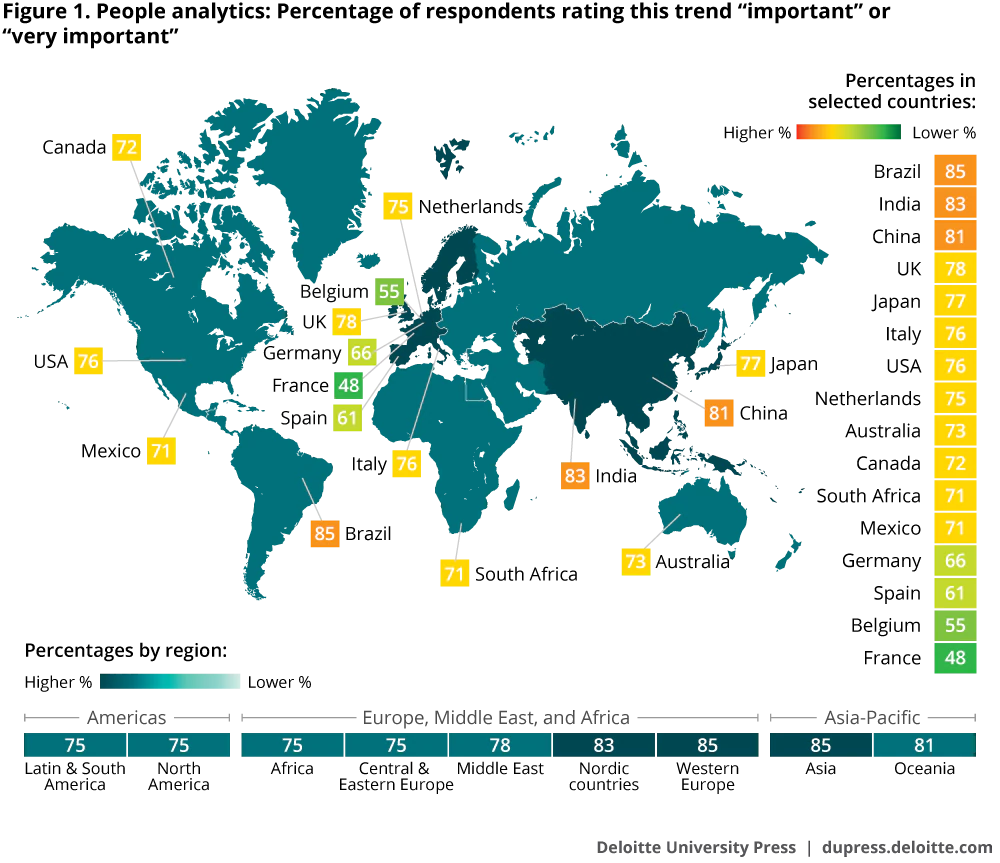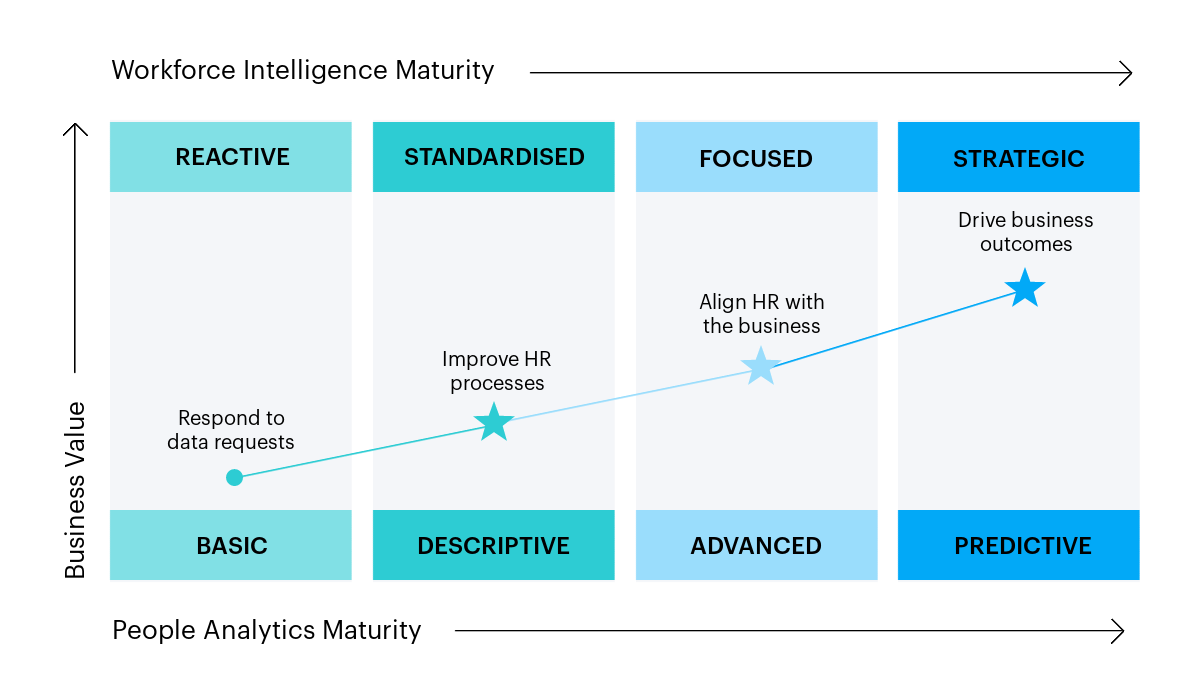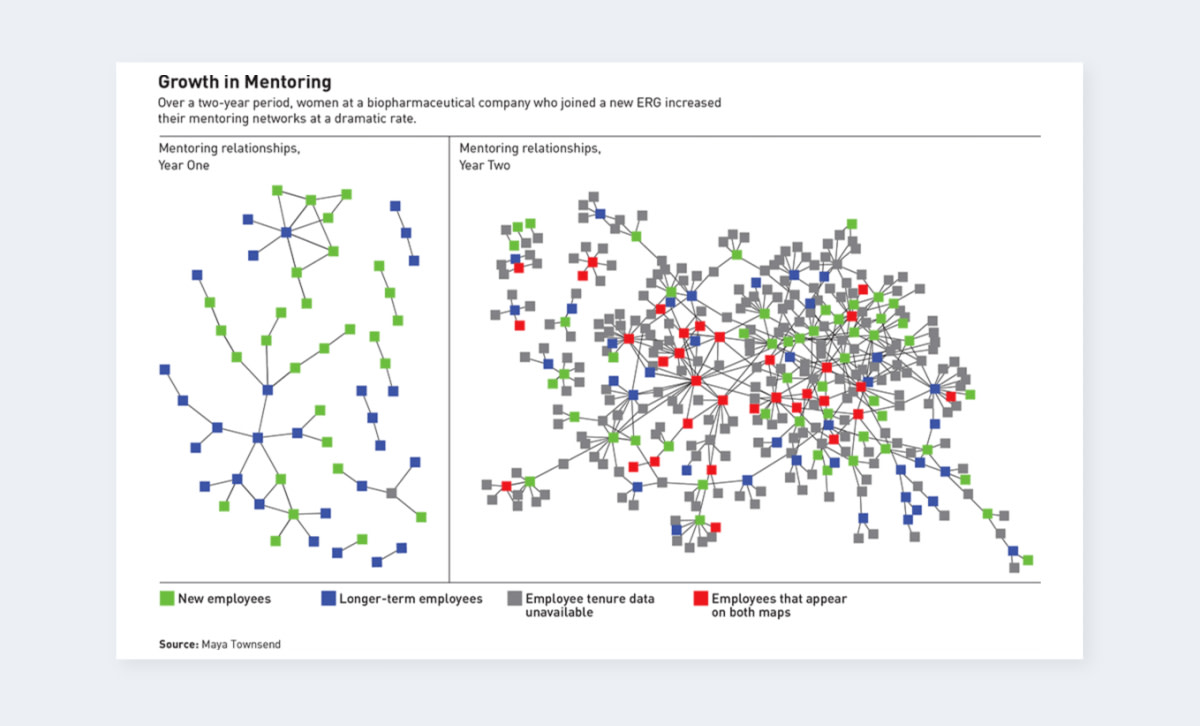How Your People Analytics Maturity Impacts Your HR Strategy
Continuously developing your people analytics maturity impacts your organization's HR strategy and business efficiency. Learn more.

Does your organization factor people analytics maturity into the HR strategy? If not, it’s time to start. The UK’s Chartered Institute of Personnel and Development� says, “Without effective people analytics practices, processes and systems, and without continued development of the people analytics skills and confidence of people professionals, the HR profession risks losing out on the performance, productivity, and job quality gains that can come from improvements in evidence-based decision making.” According to Josh Bersin, 69% of companies in the U.S. are already integrating data to build a people analytics database.
In a recent Harvard Business Review publication, Ian Cook, VP of People Analytics at Visier, said, “Appreciating the business value that analytics provides is nothing new. What is new is applying those same principles to people data with similar expectations of high-value business outcomes. People analytics provides a solid and indisputable point of truth to measure the impact of employees on business performance—and the impact the business has on employees.”
In HR’s 2.0 model, people analytics is a distinct team in the HR department that reports directly into the CHRO, but has dotted lines into other directors in Finance, Customer Service, and Operations. Deloitte University Press carried out research to show how important organizations all over the world think people analytics is. More than 3/4 of companies in the U.S., China, India, Brazil, UK, Japan and Italy rated the people analytics trend as important or very important.

This chart shows how countries rank the importance of people analytics. Image source: Deloitte University Press
Where are you on the people analytics maturity scale?
So, how important does your organization think people analytics is? How mature are your people analytics practices and what are your plans to grow this department? Refer to Visier’s people analytics maturity model to help you decide.

This people analytics maturity model demonstrates that as a company’s people analytics maturity increases, so does the business value of people analytics.
Answer these questions to establish where your organization currently falls on the maturity curve.
Do you react to questions from the business and give basic responses about diversity data, time and attendance, and headcount stats?
If so, you’re likely at the beginning of your people analytics journey.
Does your organization do regular reporting on workforce statistics, such as turnover, time to hire, and reward benchmarks? Are you starting to identify trends in talent data and recommend actions that help employees, managers or directors?
If so, you’re likely in the descriptive analytics phase.
Are you managing and analyzing both business and people data to find correlations, trends, causes, and insight day-to-day in order to drive value in both HR and the business?
If so, you’re likely at the proactive stage.
Are you integrating systems into your ‘data lake’ and starting to make predictions that are helping to inform the strategy of the whole organization? Are you able to show tangible bottom-line savings or efficiencies through your people insights?
If so, you’re starting to become more mature in your people analytics.
No matter where you sit on the people analytics maturity scale, you’re on the path to identifying and leveraging great insights, and truly partnering with the business to drive value and efficiency. In fact, in their latest book, Excellence in People Analytics, Jonathan Ferrar and David Green maintain the next three years are likely to see a huge movement in the stages organizations are at.
It’s possible that those who don’t go on this journey will find themselves commercially at a disadvantage. In many ways, this is a data realization period in HR, similar to that which marketing went through 10-15 years ago.
3 Reasons why senior HR executives should mature their people analytics practices
In leaner economic times, it’s prudent for companies to be as efficient as possible. Knowing that you already hold the data—but not yet the insights—to save money, drive performance, and make efficiencies is a point worth reflecting on. You can make a difference, and even the smallest of changes can improve margins by starting right now.
Using people data to help identify ways to improve sales, productivity, and KPI achievement makes HR much more relevant to the operational side of the business. You don’t just become a partner, you and your data become a vital part of the decision-making process.
By being able to provide insight that is used as part of the strategic decision-making process by the CEO and CFO, HR elevates its role on the executive team and guarantees that its view, now backed by data, is not only valued, but actively sought.
Insights you might gain moving up the people analytics maturity curve
People analytics can identify the reasons behind high turnover, calculate the effectiveness of learning and development initiatives, and help to meaningfully build talent and leadership in business. Take a look at a few examples of amazing insights people analytics delivers to businesses like yours:
Reduce attrition by identifying “flight risks”
Microsoft recently found that over two-thirds of staff surveyed (68%) say they would stay at their company or organization for a longer period of time if changing jobs internally was made easier, with this number higher among millennials (73%) than Gen Z (65%).
Merck found the single most predictive driver of reducing ‘flight risk’ was that employees had a good number of development opportunities and objectives.
Unveil diversity pitfalls with data
Fast Company analysed text data from performance reviews of more than 25,000 people. They found that no single term in the entire data set is more reflective of ongoing workplace bias than being seen as ambitious. They found that 63% of men report being described as ambitious, compared to just 17% of women. 58% of employees under 40 see “ambitious” in their written feedback, compared to only 23% of those over 40. While 39% of white people and 57% of Asian people are described this way, a meager 14% of Latinx and 8% of Black people are.
Create a culture of respect
Donald and Charles Sull used natural language processing to analyze 1.4 million Glassdoor reviews for companies. They found the ten biggest factors about culture that influenced employees most were not friendly colleagues, flexible schedules, and manageable workloads, as might be expected. Instead, they found the following to be the top 10 contributors to a positive work culture:
Employees feeling respected
Leaders being supportive and living their core values
Toxic and unethical behaviour in management being dealt with
Benefits being equitable
Perks meeting their needs
Having learning and development opportunities
Having job security
How re-organizations were managed were the top contributors
Engagement is more than a feeling, it drives behavior and customer outcomes
Research from ISS showed two impacts that employee engagement has on customer outcomes:
Front-line service employee engagement correlates highly (0.55) with customer service and experience.
There are three main employee engagement drivers behind high customer experience in these roles: motivation to do a good job, the level to which they receive good training, and how well they understand what the customers’ expectations are.
Do employee resource groups (ERGs) work?
According to recent research, 90% of organizations in the Fortune 500 offer these groups. Their purpose is to allow people places to connect, network, and feel included. The research used organizational network analysis (ONA) to focus on the effectiveness of the women’s group in a certain company. After initial high attendance, numbers dropped at their events, but that was not the story.
The ONA was able to show an increase in knowledge sharing and conversations about how to improve work between the group. There was also an increase in mentoring within the group, as well as connections through email and other methods. There was also an increase in women in leadership positions. In short, the women’s group really worked.

This map shows the number of mentoring relationships women had at a biopharmaceutical company in a two-year period. Image source: Maya Townsend
Next steps: Connecting your HR strategy to people analytics
In order to adopt the benefits of people analytics to HR and the wider business at your organization, start by identifying where you and your organization fall on the people analytics maturity model. Then, decide where you want the business to be in 1 to 3 years.
Once you have your goal in mind, think about how you are going to get there.
If you are still in the early stages, start small. Find people internally who have the skills to start some small, but insightful, people analytics projects that drive value. These may include data scientists, computer programmers, and psychologists. Once you have the results, make sure you share these widely and start to educate people internally about the potential benefits. Don’t do this only with HR teams; look wider into operations, finance, and customer departments. Search for advocates who understand what you are trying to achieve and can help to champion your cause.
If you are more advanced, look to see how you could use technology such as Visier to do a lot of the heavy analytics work so you can focus on the more intricate insights.
Set an HR strategy that relies on data and evidence
Review your current HR strategy to ensure there are no goals or targets that don’t rely on a data-driven approach. No matter the stage you’re at, you will need buy-in for the investment required to get to where you want to get to. Build a case and paint a picture of how this could save money, enable the organization to be more efficient, and increase productivity.
Use metrics and tangible outputs to demonstrate the ROI and reasons for the investment into this area. Don’t only focus on the financial benefits—for which there are many—but also the social and ethical ones too.



